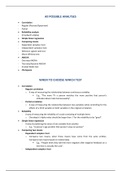Manual
Manual Statistics for Premasters
- Course
- Institution
- Book
(English below) This document is a complete overview of all statistical analyses that have been discussed during the course Statistics for Premasters (Tilburg University). First of all, it helps to determine when to use which analysis. Next, you will be explained step by step how to perform each ...
[Show more]




